Molecular Dynamics and Structure of Poly(Methyl Methacrylate) Chains Grafted from Barium Titanate Nanoparticles
Abstract
:1. Introduction
2. Materials and Methods
2.1. Materials
2.1.1. Synthesis of Hybrid Nanoparticles (Grafting of PMMA from a Surface of BTO Nps)
BTO-g-PMMA (1.25)
BTO-g-PMMA (0.43) and BTO-g-PMMA (0.18)
2.2. Methods of Hybrid Composites Characterization
3. Results and Discussion
3.1. General Characterization of BTO-g-PMMA Nanomaterials
3.2. Molecular Dynamics in BTO-g-PMMA Nanocomposites
3.2.1. Broadband Dielectric Spectroscopy
3.2.2. Solid-State NMR
3.2.3. Intermolecular Interactions and Conformational Changes
4. Conclusions
Supplementary Materials
Author Contributions
Funding
Institutional Review Board Statement
Informed Consent Statement
Data Availability Statement
Conflicts of Interest
Sample Availability
References
- Baek, Y.; Li, X.; Kim, N.; Park, C.E.; An, T.K.; Kim, J.; Kim, S.H. A critical role of amphiphilic polymers in organic-inorganic hybrid sol-gel derived gate dielectrics for flexible organic thin-film transistors. J. Mater. Chem. C 2019, 7, 11612–11620. [Google Scholar] [CrossRef]
- Chu, Y.; Qian, C.; Chahal, P.; Cao, C. Printed diodes: Materials processing, fabrication, and applications. Adv. Sci. 2019, 6, 1801653. [Google Scholar] [CrossRef] [PubMed]
- Hu, F.; An, L.; Chivate, A.T.; Guo, Z.; Khuje, S.V.; Huang, Y.; Hu, Y.; Armstrong, J.; Zhou, C.; Ren, S. Flexible and printable dielectric polymer composite with tunable permittivity and thermal stability. Chem. Commun. 2020, 56, 2332–2335. [Google Scholar] [CrossRef] [PubMed]
- Nasreen, S.; Baczkowski, M.L.; Treich, G.M.; Tefferi, M.; Anastasia, C.; Ramprasad, R.; Cao, Y.; Sotzing, G.A. Sn-polyester/polyimide hybrid flexible free-standing film as a tunable dielectric material. Macromol. Rapid Commun. 2019, 40, e1800679. [Google Scholar] [CrossRef]
- Jung, J.M.; Kim, D.H.; Hur, J.S.; Kim, H.A.; Kim, J.O.; Jeong, J.K. Acrylate-based nanocomposite zirconium-dispersed polymer dielectric for flexible oxide thin-film transistors with a curvature radius of 2 Mm. Org. Electron. 2021, 98, 106302. [Google Scholar] [CrossRef]
- Wang, Y.; Kim, H. UV-curable organic-inorganic hybrid gate dielectrics for organic thin film transistors. Org. Electron. 2012, 13, 2997–3003. [Google Scholar] [CrossRef]
- He, W.; Xu, W.; Peng, Q.; Liu, C.; Zhou, G.; Wu, S.; Zeng, M.; Zhang, Z.; Gao, J.; Gao, X.; et al. Surface modification on solution processable zro2 high-k dielectrics for low voltage operations of organic thin film transistors. J. Phys. Chem. C 2016, 120, 9949–9957. [Google Scholar] [CrossRef]
- Chon, J.; Ye, S.; Cha, K.J.; Lee, S.C.; Koo, Y.S.; Jung, J.H.; Kwon, Y.K. High-κ dielectric sol-gel hybrid materials containing barium titanate nanoparticles. Chem. Mater. 2010, 22, 5445–5452. [Google Scholar] [CrossRef]
- Huang, X.; Jiang, P. Core–shellStructured high- k polymer nanocomposites for energy storage and dielectric applications. Adv. Mater. 2015, 27, 546–554. [Google Scholar] [CrossRef]
- Tawade, B.V.; Apata, I.E.; Pradhan, N.; Karim, A.; Raghavan, D. Recent advances in the synthesis of polymer-grafted low-L and high-K nanoparticles for dielectric and electronic applications. Molecules 2021, 26, 2942. [Google Scholar] [CrossRef]
- Yan, J.; Pietrasik, J.; Wypych-Puszkarz, A.; Ciekanska, M.; Matyjaszewski, K. Synthesis of high k nanoparticles by controlled radical polymerization. In Solution-Processable Components for Organic Electronic Devices; John Wiley & Sons: Hoboken, NJ, USA, 2019; Chapter 3; ISBN 9783527813872. [Google Scholar] [CrossRef]
- Maity, N.P.; Maity, R.; Baishya, S. (Eds.) High-k Gate Dielectric Materials Applications with Advanced Metal Oxide Semiconductor Field Effect Transistors (MOSFETs); CRC Press: Boca Raton, FL, USA, 2021. [Google Scholar]
- Yan, J.; Bockstaller, M.R.; Matyjaszewski, K. Brush-modified materials: Control of molecular architecture, assembly behavior, properties and applications. Prog. Polym. Sci. 2020, 100, 101180. [Google Scholar] [CrossRef]
- Matyjaszewski, K. Advanced materials by atom transfer radical polymerization. Adv. Mater. 2018, 30, e1706441. [Google Scholar] [CrossRef] [PubMed]
- Barbey, R.; Lavanant, L.; Paripovic, D.; Schüwer, N.; Sugnaux, C.; Tugulu, S.; Klok, H.A. Polymer brushes via surface-initiated controlled radical polymerization: Synthesis, characterization, properties, and applications. Chem. Rev. 2009, 109, 5437–5527. [Google Scholar] [CrossRef] [PubMed]
- Hui, C.M.; Pietrasik, J.; Schmitt, M.; Mahoney, C.; Choi, J.; Bockstaller, M.R.; Matyjaszewski, K. Surface-initiated polymerization as an enabling tool for multifunctional (Nano-)engineered hybrid materials. Chem. Mater. 2014, 26, 745–762. [Google Scholar] [CrossRef]
- Matyjaszewski, K. Atom transfer radical polymerization (ATRP): Current status and future perspectives. Macromolecules 2012, 45, 4015–4039. [Google Scholar] [CrossRef]
- Tsujii, Y.; Ohno, K.; Yamamoto, S.; Goto, A.; Fukuda, T. Structure and properties of high-density polymer brushes prepared by surface-initiated living radical polymerization. Adv. Polym. Sci. 2006, 197, 1–45. [Google Scholar]
- Michalek, L.; Barner, L.; Barner-Kowollik, C. Polymer on top: Current limits and future perspectives of quantitatively evaluating surface grafting. Adv. Mater. 2018, 30, e1706321. [Google Scholar] [CrossRef]
- Zuo, B.; Li, C.; Xu, Q.; Randazzo, K.; Jiang, N.; Wang, X.; Priestley, R.D. Ultrastable glassy polymer films with an ultradense brush morphology. ACS Nano 2021, 15, 9568–9576. [Google Scholar] [CrossRef]
- Poling-Skutvik, R.; Olafson, K.N.; Narayanan, S.; Stingaciu, L.; Faraone, A.; Conrad, J.C.; Krishnamoorti, R. Confined dynamics of grafted polymer chains in solutions of linear polymer. Macromolecules 2017, 50, 7372–7379. [Google Scholar] [CrossRef]
- Ghanbari, A.; Rahimi, M.; Dehghany, J. Influence of surface grafted polymers on the polymer dynamics in a silica-polystyrene nanocomposite: A coarse-grained molecular dynamics investigation. J. Phys. Chem. C 2013, 117, 25069–25076. [Google Scholar] [CrossRef]
- Hałagan, K.; Banaszak, M.; Jung, J.; Polanowski, P.; Sikorski, A. Dynamics of opposing polymer brushes: A computer simulation study. Polymers 2021, 13, 2758. [Google Scholar] [CrossRef]
- Jenczyk, J.; Woźniak-Budych, M.; Jancelewicz, M.; Jarek, M.; Jurga, S. Structural and dynamic study of block copolymer–Nanoparticles nanocomposites. Polymer 2019, 167, 130–137. [Google Scholar] [CrossRef]
- Deng, B.; Palermo, E.F.; Shi, Y. Comparison of chain-growth polymerization in solution versus on surface using reactive coarse-grained simulations. Polymer 2017, 129, 105–116. [Google Scholar] [CrossRef]
- Liu, H.; Li, M.; Lu, Z.Y.; Zhang, Z.G.; Sun, C.C. Influence of surface-initiated polymerization rate and initiator density on the properties of polymer brushes. Macromolecules 2009, 42, 2863–2872. [Google Scholar] [CrossRef]
- Hore, M.J.A. Polymers on nanoparticles: Structure & dynamics. Soft Matter 2019, 15, 1120–1134. [Google Scholar] [CrossRef] [PubMed]
- Tsuda, K.; Kobayashi, S.; Otsu, T. Vinyl polymerization. CXVI. The effects of several sulfides and oxides on radical polymerization. Bull. Chem. Soc. Jpn. 1965, 38, 1517–1522. [Google Scholar] [CrossRef]
- Yan, J.; Pan, X.; Wang, Z.; Lu, Z.; Wang, Y.; Liu, L.; Zhang, J.; Ho, C.; Bockstaller, M.R.; Matyjaszewski, K. A fatty acid-inspired tetherable initiator for surface-initiated atom transfer radical polymerization. Chem. Mater. 2017, 29, 4963–4969. [Google Scholar] [CrossRef]
- Baeten, F.; Derks, B.; Coppens, W.; van Kleef, E. Barium titanate characterization by differential scanning calorimetry. J. Eur. Ceram. Soc. 2006, 26, 589–592. [Google Scholar] [CrossRef]
- Roth, C.B.; Dutcher, J.R. Glass transition temperature of freely-standing films of atactic poly(Methyl methacrylate). Eur. Phys. J. E 2003, 12, 91–95. [Google Scholar] [CrossRef]
- Mohammadi, M.; Fazli, H.; Karevan, M.; Davoodi, J. The glass transition temperature of PMMA: A molecular dynamics study and comparison of various determination methods. Eur. Polym. J. 2017, 91, 121–133. [Google Scholar] [CrossRef]
- Porter, C.E.; Blum, F.D. Thermal characterization of adsorbed polystyrene using modulated differential scanning calorimetry. Macromolecules 2002, 35, 7448–7452. [Google Scholar] [CrossRef]
- Hong, R.Y.; Qian, J.Z.; Cao, J.X. Synthesis and characterization of PMMA grafted ZnO nanoparticles. Powder Technol. 2006, 163, 160–168. [Google Scholar] [CrossRef]
- Dang, A.; Hui, C.M.; Ferebee, R.; Kubiak, J.; Li, T.; Matyjaszewski, K.; Bockstaller, M.R. Thermal properties of particle brush materials: Effect of polymer graft architecture on the glass transition temperature in polymer-grafted colloidal systems. Macromol. Symp. 2013, 331–332, 9–16. [Google Scholar] [CrossRef]
- Vallés, C.; Papageorgiou, D.G.; Lin, F.; Li, Z.; Spencer, B.F.; Young, R.J.; Kinloch, I.A. PMMA-grafted graphene nanoplatelets to reinforce the mechanical and thermal properties of PMMA composites. Carbon N. Y. 2020, 157, 750–760. [Google Scholar] [CrossRef]
- Wypych, A.; Duval, E.; Boiteux, G.; Ulanski, J.; David, L.; Mermet, A. Effect of physical aging on nano- and macroscopic properties of poly(Methyl methacrylate) glass. Polymer 2005, 46, 12523–12531. [Google Scholar] [CrossRef]
- Bak, W.; Dulian, P.; Sitko, D.; Garbarz-Glos, B.; Kajtoch, C.; Wieczorek-Ciurowa, K.; Smeltere, I. Effect of variable valence ion doping on the dielectric properties of BaTiO3 –based materials. Ferroelectrics 2014, 464, 35–41. [Google Scholar] [CrossRef]
- Lu, W.; Quilitz, M.; Schmidt, H. Nanoscaled BaTiO3 powders with a large surface area synthesized by precipitation from aqueous solutions: Preparation, characterization and sintering. J. Eur. Ceram. Soc. 2007, 27, 3149–3159. [Google Scholar] [CrossRef]
- Shaw, T.M.; Trolier-McKinstry, S.; McIntyre, P.C. The properties of ferroelectric films at small dimensions. Annu. Rev. Mater. Sci. 2000, 30, 263–298. [Google Scholar] [CrossRef]
- Hossain, M.E.; Liu, S.Y.; O’Brien, S.; Li, J. Modeling of high-k dielectric nanocomposites. Acta Mech. 2014, 225, 1197–1209. [Google Scholar] [CrossRef]
- Xie, L.; Huang, X.; Wu, C.; Jiang, P. Core–shell structured poly(methyl methacrylate)/BaTiO3 nanocomposites prepared by in situ atom transfer radical polymerization: A route to high dielectric constant materials with the inherent low loss of the base polymer. J. Mater. Chem. 2011, 21, 5897–5906. [Google Scholar] [CrossRef]
- Kremer, F.; Schönhals, A. Broadband Dielectric Spectroscopy; Springer: Berlin/Heidelberg, Germany, 2003; ISBN 978-3-642-56120-7. [Google Scholar]
- Angell, C.A.; Ngai, K.L.; McKenna, G.B.; McMillan, P.F.; Martin, S.W. Relaxation in glassforming liquids and amorphous solids. J. Appl. Phys. 2000, 88, 3113–3157. [Google Scholar] [CrossRef]
- N’Diaye, M.; Pascaretti-Grizon, F.; Massin, P.; Baslé, M.F.; Chappard, D. Water absorption of poly(methyl methacrylate) measured by vertical interference microscopy. Langmuir 2012, 28, 11609–11614. [Google Scholar] [CrossRef] [PubMed]
- Zhang, Y.; Fry, C.G.; Pedersen, J.A.; Hamers, R.J. Dynamics and Morphology of Nanoparticle-Linked Polymers Elucidated by Nuclear Magnetic Resonance. Anal. Chem. 2017, 89, 12399–12407. [Google Scholar] [CrossRef] [PubMed]
- Hostetler, M.J.; Wingate, J.E.; Zhong, C.; Harris, J.E.; Vachet, R.W.; Clark, M.R.; Londono, J.D.; Green, S.J.; Stokes, J.J.; Wignall, G.D.; et al. Alkanethiolate gold cluster molecules with core diameters from 1.5 to 5.2 nm: Core and monolayer properties as a Function of Core Size. Langmuir 2008, 7463, 17–30. [Google Scholar] [CrossRef]
- Badia, A.; Cuccia, L.; Demers, L.; Morin, F.; Lennox, R.B. Structure and dynamics in alkanethiolate monolayers self-assembled on gold nanoparticles: A DSC, FT-IR, and Deuterium NMR Study. J. Am. Chem. Soc. 1997, 7863, 2682–2692. [Google Scholar] [CrossRef]
- Song, Y.; Harper, A.S.; Murray, R.W.; Hill, C.; Carolina, N. Ligand heterogeneity on monolayer-protected gold clusters. Langmuir 2005, 21, 5492–5500. [Google Scholar] [CrossRef]
- Marbella, L.E.; Millstone, J.E. NMR techniques for noble metal nanoparticles. Chem. Mater. 2015, 27, 2721–2739. [Google Scholar] [CrossRef]
- Bassan, P.; Byrne, H.J.; Bonnier, F.; Lee, J.; Dumas, P.; Gardner, P. Resonant mie scattering in infrared spectroscopy of biological materials—Understanding the “Dispersion artefact”. Analyst 2009, 134, 1586–1593. [Google Scholar] [CrossRef]
- Arblaster, J.W. Crystallographic properties of ruthenium. Platin. Met. Rev. 2013, 57, 127–136. [Google Scholar] [CrossRef]
- Stanke, D.; Hallensleben, M.L.; Toppare, L. Graft copolymers and composites of poly(methyl methacrylate) and polypyrrole part II. Synth. Met. 1995, 73, 261–266. [Google Scholar] [CrossRef]
- Piechocki, K.; Kozanecki, M.; Saramak, J. Water structure and hydration of polymer network in PMEO2MA hydrogels. Polymer 2020, 210, 122974. [Google Scholar] [CrossRef]
- Alsharaeh, E.H. Polystyrene-poly(methyl methacrylate) silver nanocomposites: Significant modification of the thermal and electrical properties by microwave irradiation. Materials 2016, 9, 458. [Google Scholar] [CrossRef] [PubMed]
- Haris, M.R.M.; Kathiresan, S.; Mohan, S. FT-IR and FT-raman spectra and normal coordinate analysis of poly methyl methacrylate. Der Pharma Chem. 2010, 2, 316–323. [Google Scholar]
- Ohno, K.; Morinaga, T.; Takeno, S.; Tsujii, Y.; Fukuda, T. Suspensions of Silica Particles Grafted with Concentrated Polymer Brush: Effects of Graft Chain Length on Brush Layer Thickness and Colloidal Crystallization. Macromolecules 2007, 40, 9143–9150. [Google Scholar] [CrossRef]
- Blaszczyk-Lezak, I.; Hernández, M.; Mijangos, C. One dimensional PMMA nanofibers from AAO templates. Evidence of confinement effects by dielectric and raman analysis. Macromolecules 2013, 46, 4995–5002. [Google Scholar] [CrossRef]
- Olejniczak, M.N.; Piechocki, K.; Kozanecki, M.; Koynov, K.; Adamus, A.; Wach, R.A. The influence of selected NSAIDs on volume phase transition in poly(2-(2-methoxyethoxy)ethyl methacrylate) hydrogels. J. Mater. Chem. B 2016, 4, 1528–1534. [Google Scholar] [CrossRef] [Green Version]
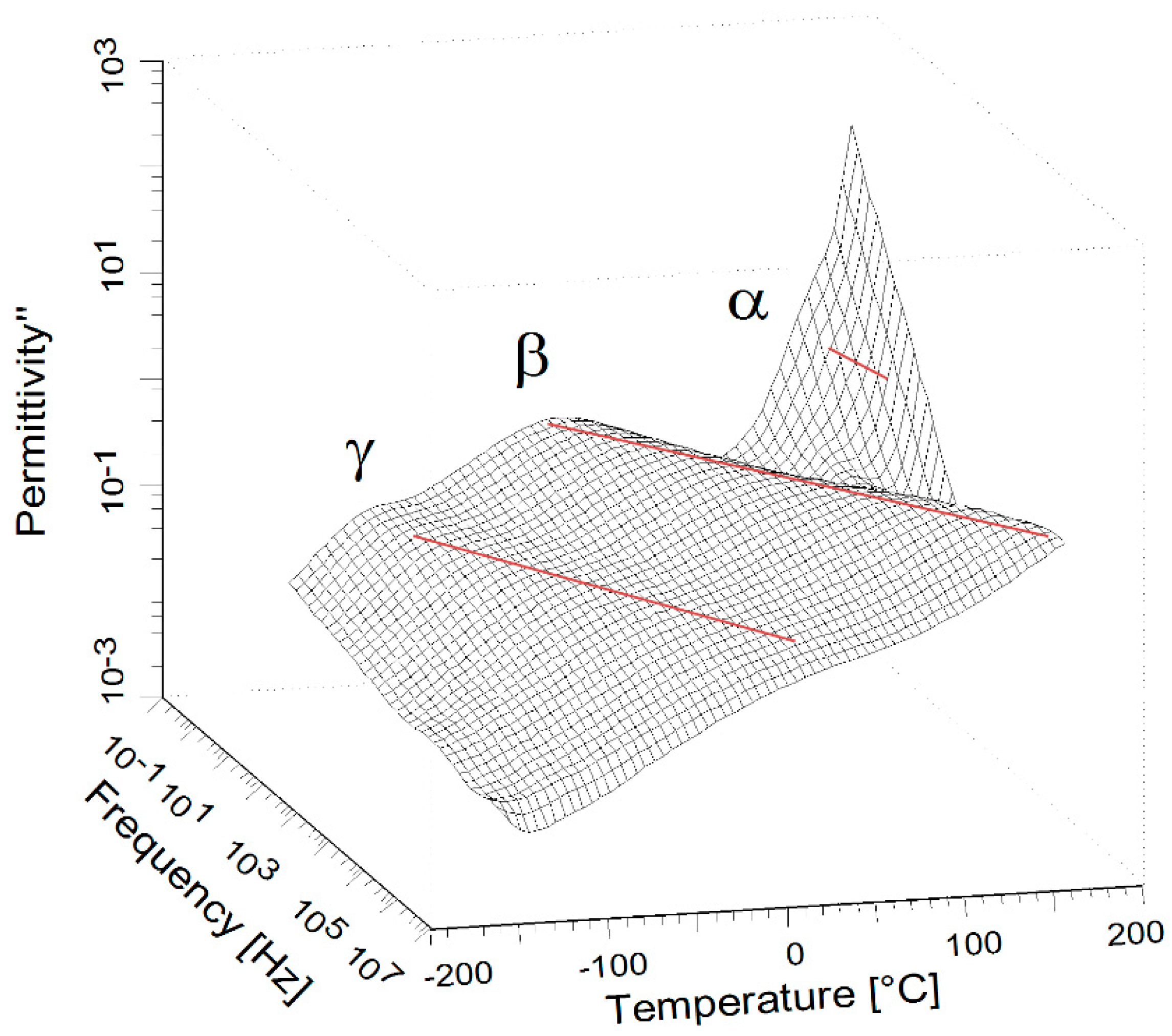
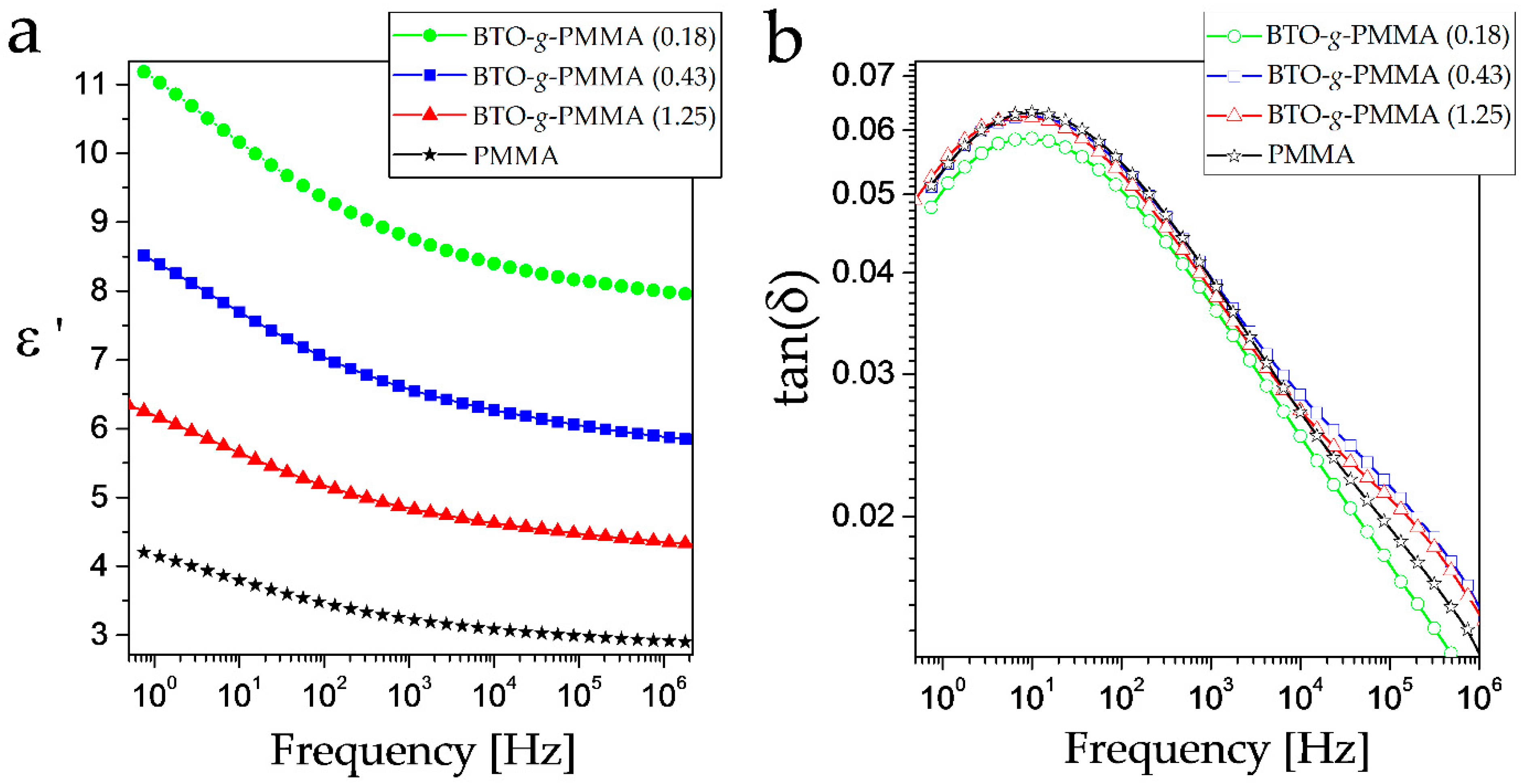
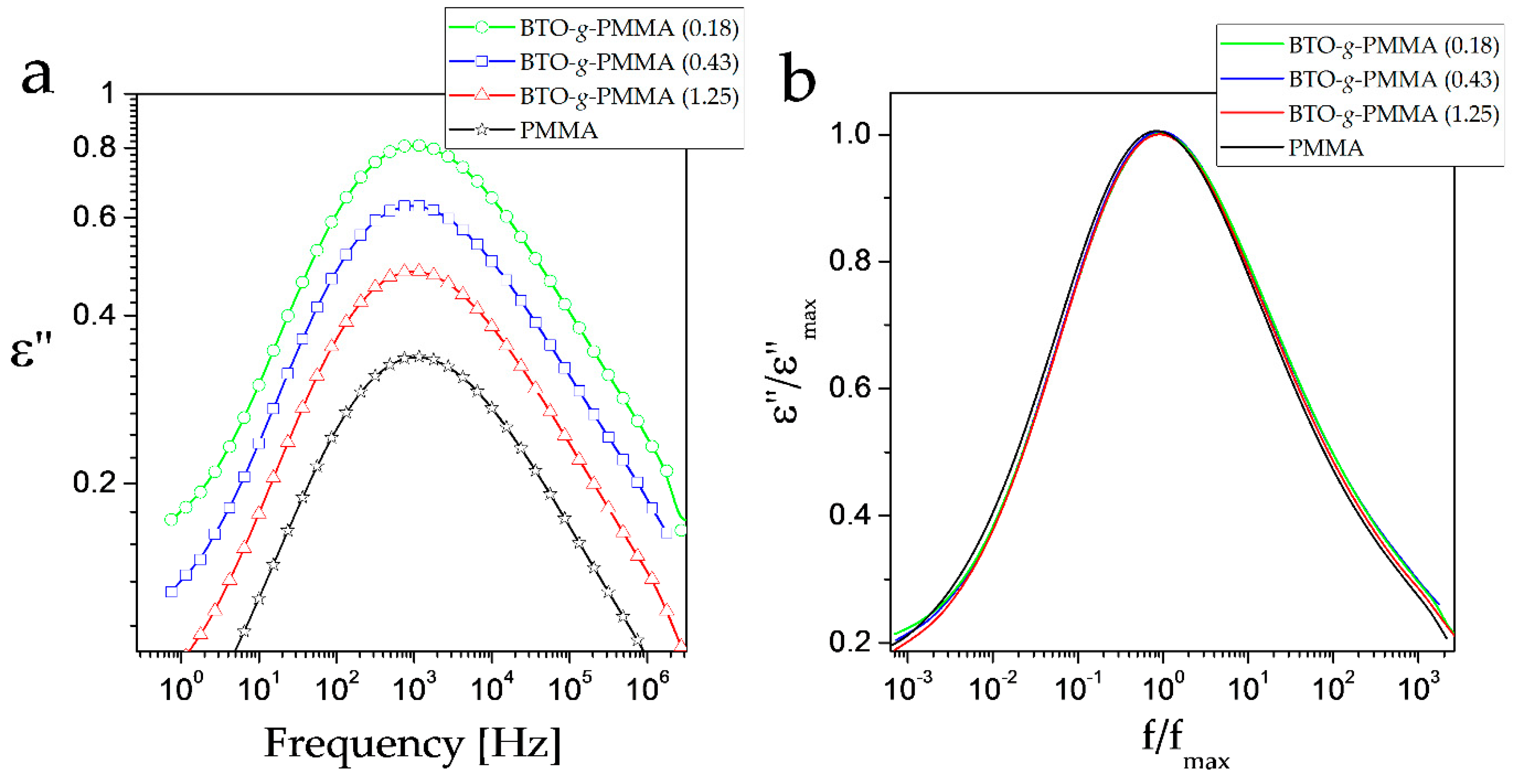
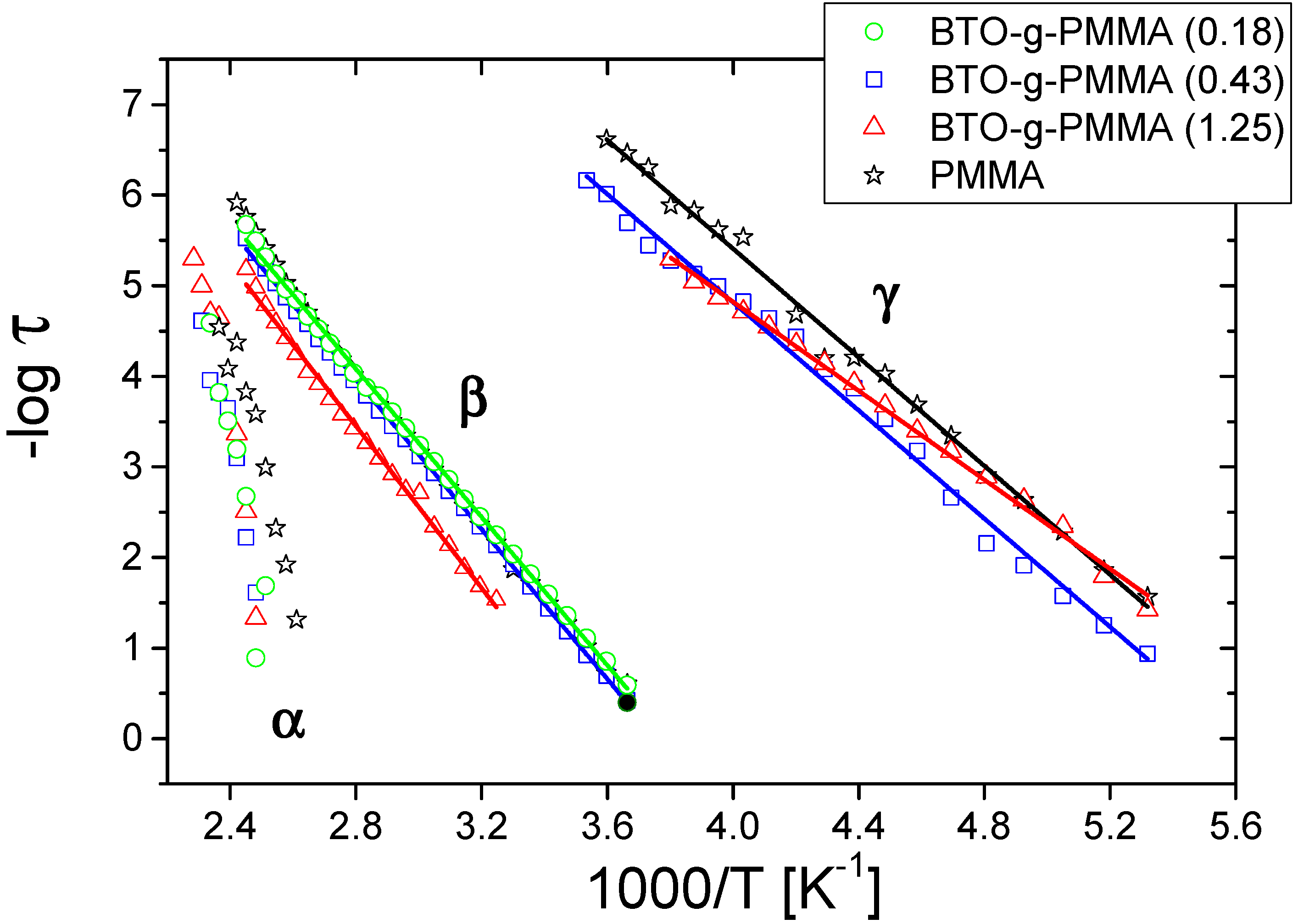
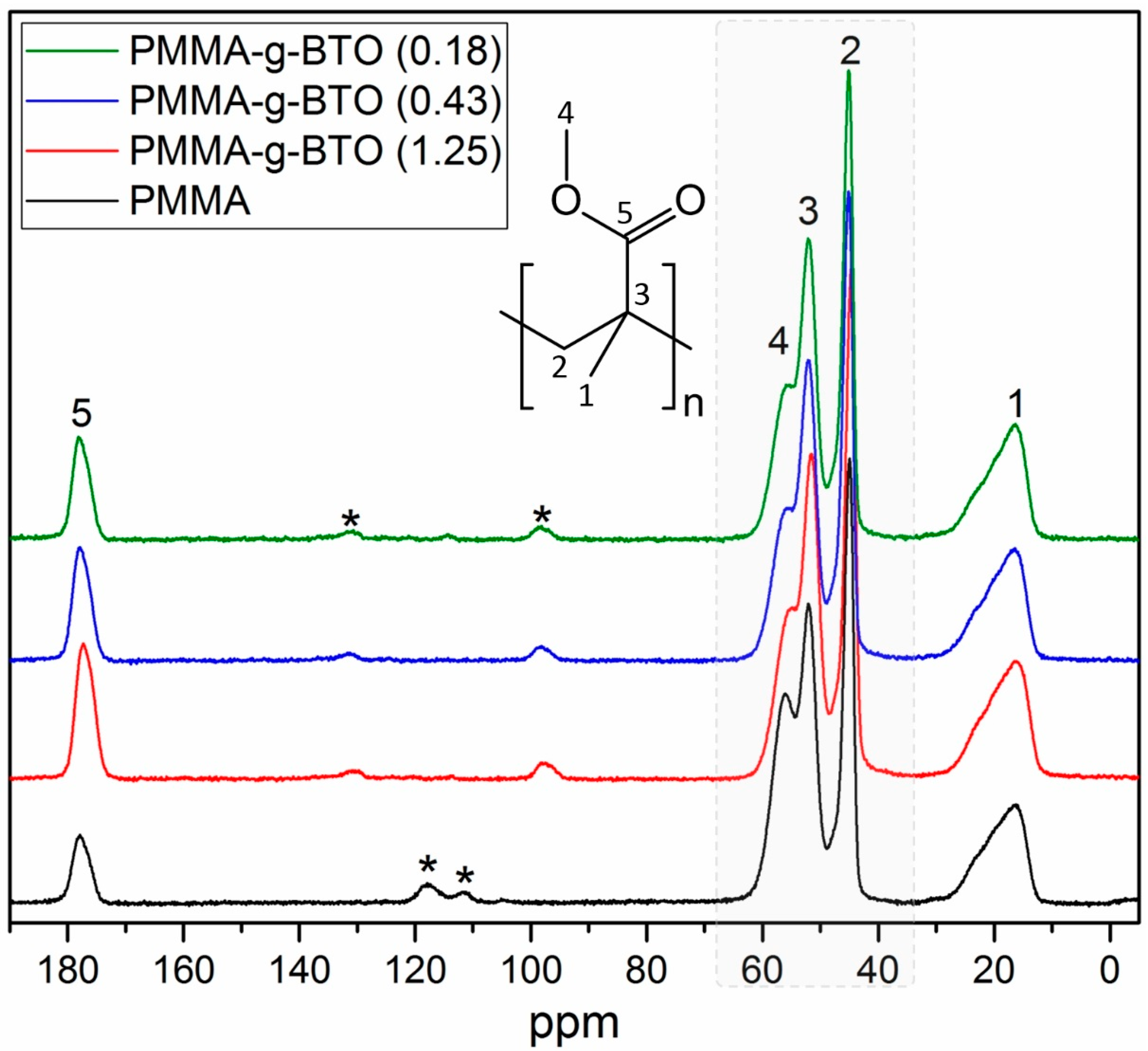
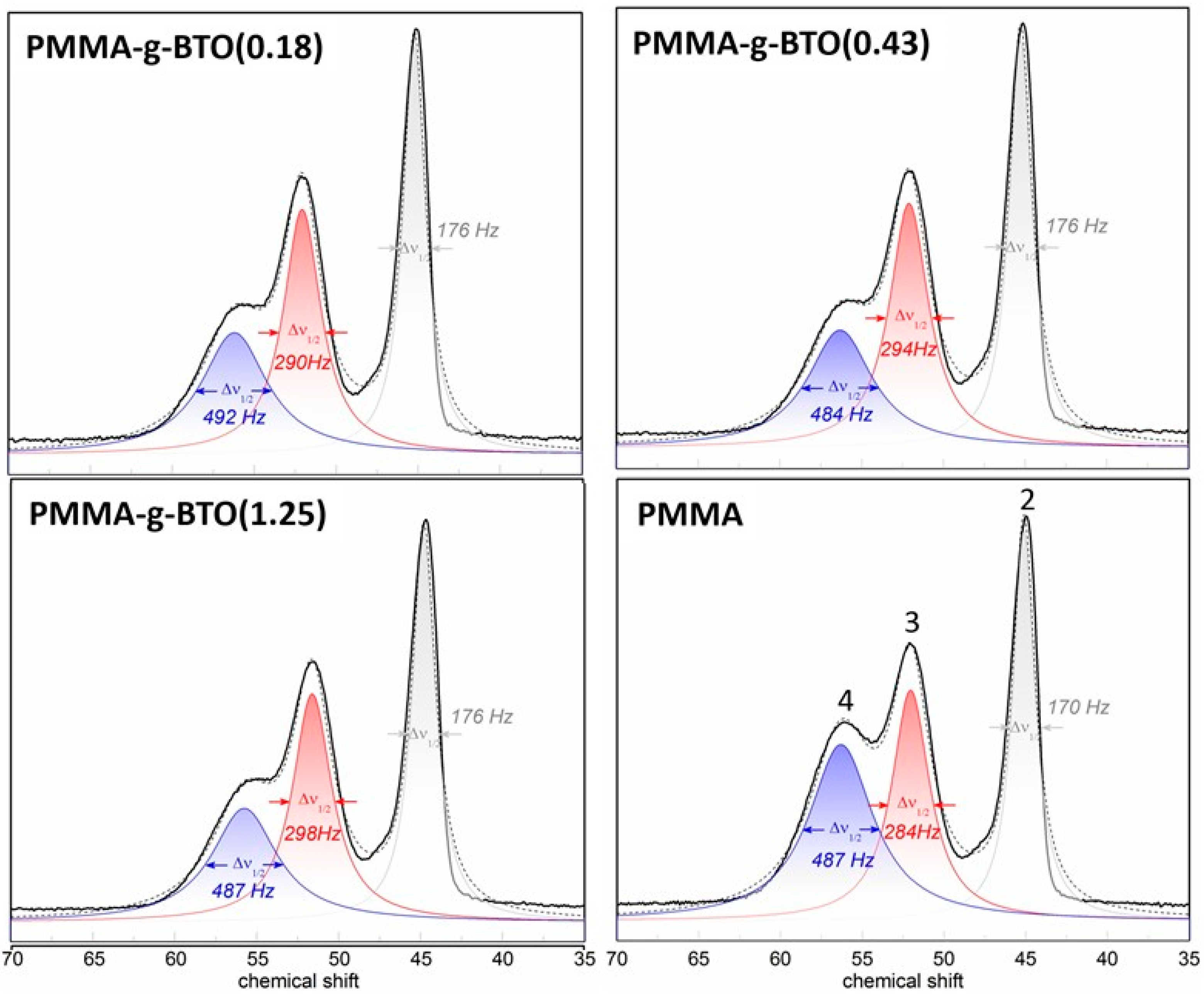
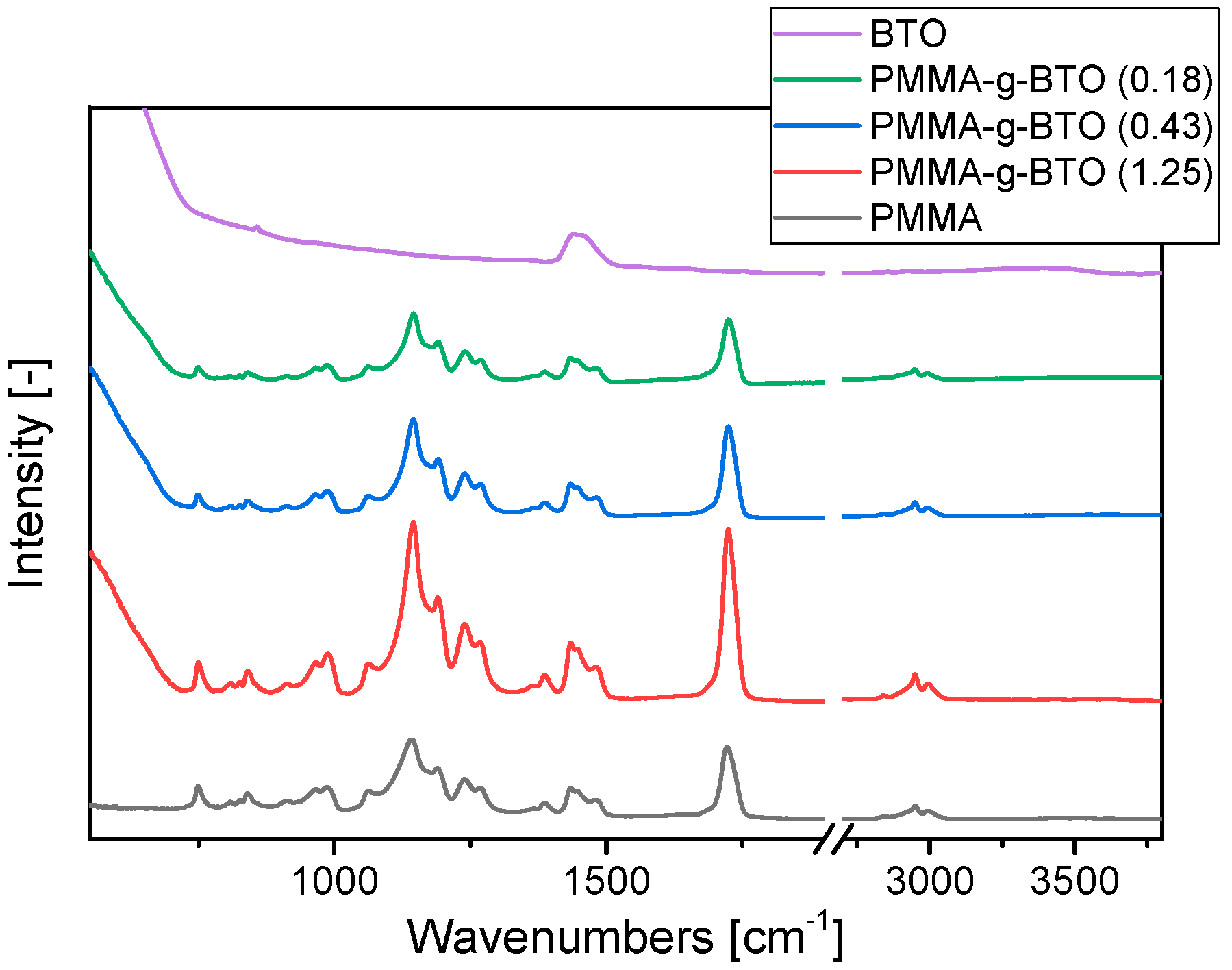
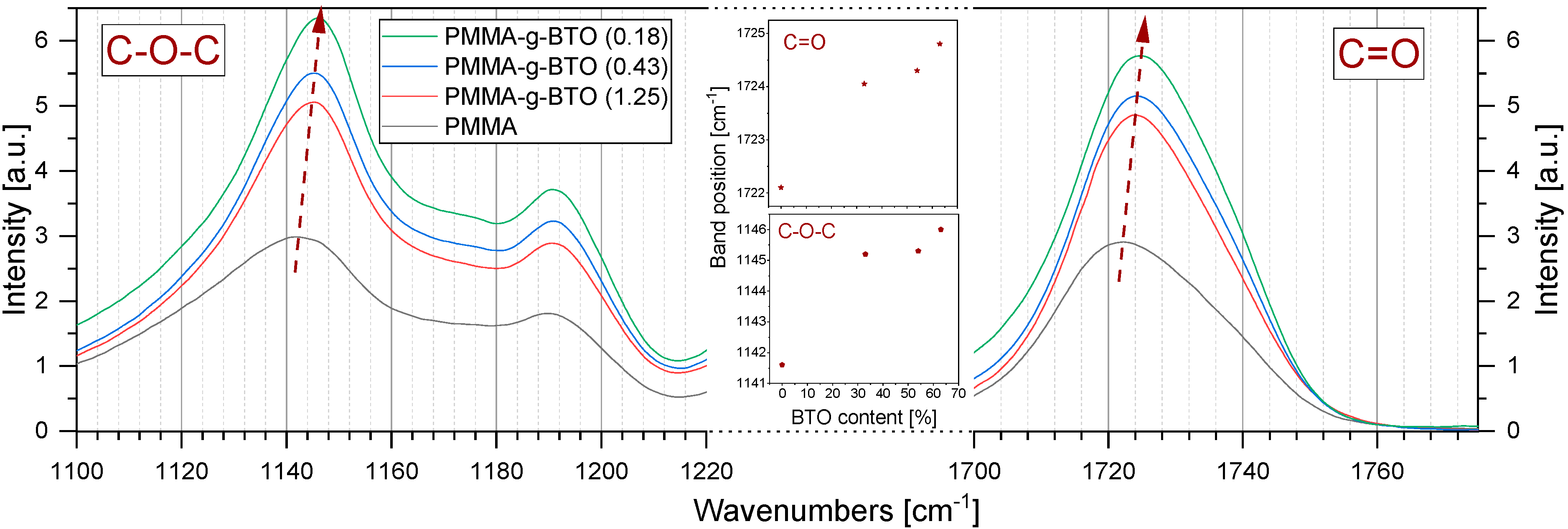
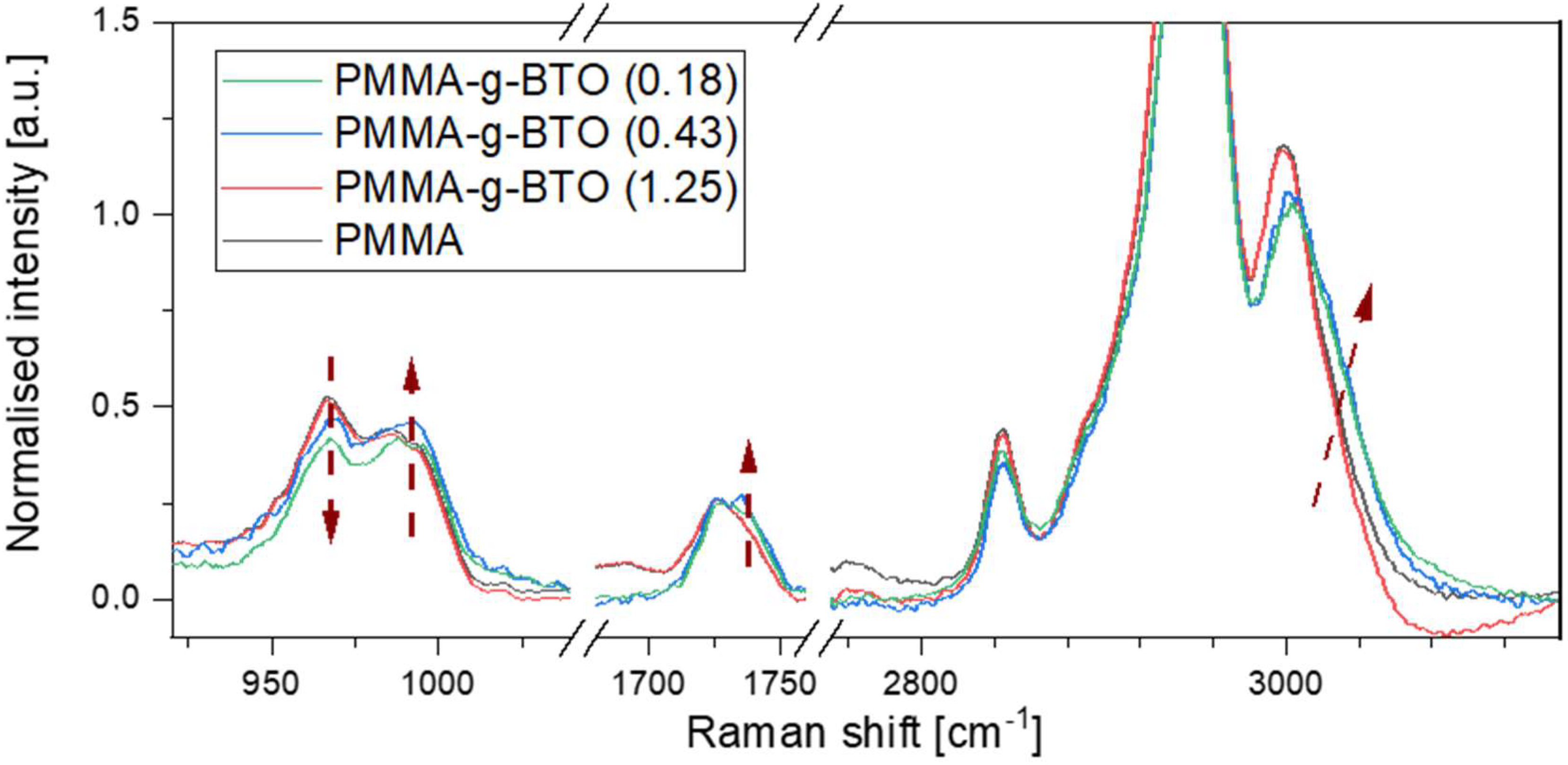
| Sample Name | PMMA Mn | PMMA Mw/Mn | Grafting Density (chain/nm2) | f(inorg) | Tg (°C) Range | |
|---|---|---|---|---|---|---|
| Onset Point | Endset Point | |||||
| PMMA | 3.50 × 105 | 1.17 | - | 0% | 91 | 137 |
| BTO-g-PMMA (1.25) | 1.52 × 105 | 1.77 | 1.25 | 33% | 103.5 | 144 |
| BTO-g-PMMA (0.43) | 1.85 × 105 | 2.38 | 0.43 | 54% | 109 | 142 |
| BTO-g-PMMA (0.18) | 3.18 × 105 | 1.38 | 0.18 | 62% | 111 | 142 |
| Sample | τ (s) | τmax (s) | Δε | αHN | βHN |
|---|---|---|---|---|---|
| PMMA | 4.9 × 10−4 | 1.4 × 10−4 | 2.13 | 0.52 | 0.51 |
| BTO-g-PMMA (1.25) | 5.4 × 10−4 | 1.6 × 10−4 | 2.72 | 0.53 | 0.51 |
| BTO-g-PMMA (0.43) | 6.4 × 10−4 | 1.7 × 10−4 | 3.83 | 0.53 | 0.47 |
| BTO-g-PMMA (0.18) | 5.7 × 10−4 | 1.5 × 10−4 | 4.87 | 0.53 | 0.48 |
| Sample’s Name | EA of β Relaxation [kJ/mol] | ΕA of γ Relaxation [kJ/mol] ± 2 |
|---|---|---|
| PMMA | 81.9 ± 0.9 | 57 |
| BTO-g-PMMA (1.25) | 85.7 ± 1.3 | 47 |
| BTO-g-PMMA (0.43) | 79.1 ± 0.4 | 57 |
| BTO-g-PMMA (0.18) | 78.3 ± 0.6 | γ not visible |
Publisher’s Note: MDPI stays neutral with regard to jurisdictional claims in published maps and institutional affiliations. |
© 2022 by the authors. Licensee MDPI, Basel, Switzerland. This article is an open access article distributed under the terms and conditions of the Creative Commons Attribution (CC BY) license (https://creativecommons.org/licenses/by/4.0/).
Share and Cite
Wypych-Puszkarz, A.; Cetinkaya, O.; Yan, J.; Udovytska, R.; Jung, J.; Jenczyk, J.; Nowaczyk, G.; Jurga, S.; Ulański, J.; Matyjaszewski, K.; et al. Molecular Dynamics and Structure of Poly(Methyl Methacrylate) Chains Grafted from Barium Titanate Nanoparticles. Molecules 2022, 27, 6372. https://doi.org/10.3390/molecules27196372
Wypych-Puszkarz A, Cetinkaya O, Yan J, Udovytska R, Jung J, Jenczyk J, Nowaczyk G, Jurga S, Ulański J, Matyjaszewski K, et al. Molecular Dynamics and Structure of Poly(Methyl Methacrylate) Chains Grafted from Barium Titanate Nanoparticles. Molecules. 2022; 27(19):6372. https://doi.org/10.3390/molecules27196372
Chicago/Turabian StyleWypych-Puszkarz, Aleksandra, Onur Cetinkaya, Jiajun Yan, Ruslana Udovytska, Jarosław Jung, Jacek Jenczyk, Grzegorz Nowaczyk, Stefan Jurga, Jacek Ulański, Krzysztof Matyjaszewski, and et al. 2022. "Molecular Dynamics and Structure of Poly(Methyl Methacrylate) Chains Grafted from Barium Titanate Nanoparticles" Molecules 27, no. 19: 6372. https://doi.org/10.3390/molecules27196372






